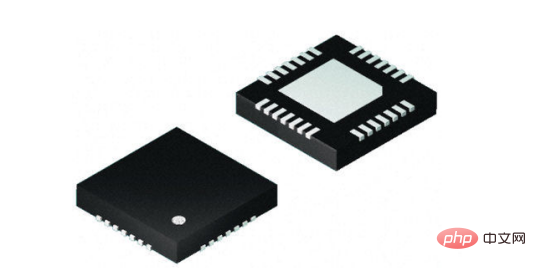Home >Common Problem >What memory can the CPU directly access?
The memory that the CPU can directly access is: internal memory. Internal memory, also known as memory, is a storage space that the CPU can directly address and is made of semiconductor devices. Internal memory is the bridge between external memory and the CPU. All programs in the computer run in memory. As long as the computer is running, the operating system will transfer the data that needs to be calculated from the memory to the CPU for calculation; when the calculation is completed, the CPU will transmit the results. The operation of the memory also determines the stable operation of the computer.

The operating environment of this tutorial: Windows 7 system, Dell G3 computer.
Internal memory is a storage space that the CPU can directly address and is made of semiconductor devices. It is characterized by fast access speed.
Internal memory, also known as memory, is one of the important components in the computer. It is the bridge between external memory and the CPU. All programs in the computer run in the memory.
The performance of memory has a great impact on the computer. The function of memory is to temporarily store calculation data in the CPU and data exchanged with external memories such as hard disks.
As long as the computer is running, the operating system will transfer the data that needs to be calculated from the memory to the CPU for calculation. When the operation is completed, the CPU transmits the results, and the operation of the memory also determines the stable operation of the computer.

#Memory is the main component in the computer, which is relative to external memory.
The programs we usually use, such as: Windows operating system, typing software, game software, etc. They are generally installed on external storage such as hard disks, but their functions cannot be used only because they must be transferred into memory to run in order to truly use their functions.
When we usually enter a piece of text or play a game, we actually do it in memory. Just like in a study room, the bookshelves and bookcases where books are stored are equivalent to the external storage of the computer, and the desk where we work is equivalent to the memory.
Usually, we store large amounts of data that need to be saved permanently on external memory, and put some temporary or small amounts of data and programs on memory. Of course, the quality of the memory will directly affect the running speed of the computer.
Memory is a place where programs and data are temporarily stored. When we use WPS to process a document, when you type characters on the keyboard, it is stored in memory. When you choose to save, the data in the memory will be saved to the hard (disk) disk.

Types of internal memory
Internal memory is composed of random access memory and read-only memory constituted.
Read-Only Memory (ROM)
Read-Only Memory (ROM) works in a non-destructive readout mode and can only be read but not written Enter information. Once the information is written, it is fixed and will not be lost even if the power is turned off, so it is also called fixed memory. The data stored in ROM is usually written before being loaded into the whole machine. It can only be read out during the operation of the whole machine. Unlike random access memory, the stored content can be rewritten quickly and conveniently. The data stored in ROM is stable and will not change after a power outage. It has a simple structure and is easy to use, so it is often used to store various fixed programs and data.
The characteristic of ROM is that it can only read information but cannot write information. Usually, a basic input/output system is solidified in the ROM of the computer motherboard, called BIOS (Basic Input Output System). Its main function is to complete the power-on self-test of the system, initialization of each functional module in the system, basic input/output driver of the system and boot operating system.
There are many types of ROM, and each type of read-only memory has its own characteristics and scope of application. According to its manufacturing process and function, there are five types of ROM, namely mask-programmed read-only memory MROM (Mask-programmed ROM), programmable read-only memory PROM (Programmable ROM), erasable and programmable read-only memory Memory EPROM (Erasable Programmable ROM), electrically erasable programmable read-only memory EEPROM (Electrically Erasable Programmable ROM) and flash erasable read-write memory (Flash Memory).
Random Access Memory (RAM)
Random Access Memory (English: Random Access Memory, abbreviation: RAM), also called main memory, exchanges data directly with the CPU of internal memory. It can be read and written at any time (except when refreshing), is very fast, and is often used as a temporary data storage medium for the operating system or other running programs. When RAM is working, information can be written (stored) or read (retrieved) from any specified address at any time. The biggest difference between it and ROM is the volatility of data, that is, the stored data will be lost once the power is turned off. RAM is used in computers and digital systems to temporarily store programs, data, and intermediate results.
Characteristics of RAM:
Random access
The so-called "random access" means that when data in the memory is read or written, the time required has nothing to do with the location of the information or the location where it is written. In contrast, when reading or writing information in a Sequential Access storage device, the time and location required are related. It is mainly used to store the operating system, various applications, data, etc.
When RAM is working normally, data can be read from RAM or written to RAM. Compared with ROM, RAM has the advantages of easy reading/writing and flexible use. It is especially suitable for situations where data is frequently and quickly changed.
Volatile
RAM cannot retain data when the power is turned off. If data needs to be saved, they must be written to a long-term storage device (such as a hard drive).
The working characteristic of RAM is that after power is turned on, data information can be accessed at any location at any time, and the internal information will disappear after power is turned off.
Sensitive to static electricity
Like other delicate integrated circuits, random access memory is very sensitive to electrostatic charges in the environment. Static electricity can interfere with the charge of the capacitors in the memory, causing data loss or even burning out the circuit. Therefore, before touching the random access memory, you should first touch the metal ground with your hand.
Access speed
Modern random access memory has the fastest writing and reading speeds among almost all access devices, with access delays and other mechanical operations involved. It is also insignificant compared to other storage devices.
Requires Refresh
Modern random access memories rely on capacitors to store data. A fully charged capacitor represents a 1 (binary), and an uncharged capacitor represents a 0. Since capacitors have leakage to some extent, data will gradually be lost over time if no special treatment is taken. Refreshing means periodically reading the status of the capacitor and then recharging the capacitor according to its original status to make up for the lost charge. The need to refresh explains exactly the volatile nature of random access memory.
For more related knowledge, please visit: PHP Chinese website!
The above is the detailed content of What memory can the CPU directly access?. For more information, please follow other related articles on the PHP Chinese website!